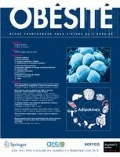Résumé
L’objectif de cette étude était d’analyser l’effet de la cohorte de naissance dans l’évolution de la prévalence de l’obésité après prise en compte de l’âge et de la période d’enquête. Pour chaque année d’enquête ObEpi (1997, 2000, 2003, 2006), des données sur le poids et la taille ont été obtenues par des questionnaires envoyés à 20 000 ménages représentatifs de la population nationale. La prévalence de l’obésité a été analysée à l’aide d’un modèle logistique, avec l’âge, la période et la cohorte comme variables explicatives. Étant donné la relation linéaire entre ces variables, seuls les effets non linéaires peuvent être estimés de manière unique dans un modèle avec certaines contraintes imposées par le statisticien. Un écart important à la linéarité a été noté pour l’effet cohorte uniquement: nous avons observé une accélération de l’augmentation de la prévalence de l’obésité pour les sujets nés à partir du milieu des années 1960, aussi bien pour les hommes que pour les femmes, mais de façon plus prononcée pour les femmes. Ces résultats suggèrent que, comparés aux anciennes générations, les hommes et les femmes nés après les années 1960 ont été exposés à un environnement qui a augmenté leur susceptibilité à l’obésité tout au long de la vie.
Abstract
We investigated the impact of birth cohort on the changes in obesity prevalence after taking into account age and survey period.We analyzed data from 4 national surveys conducted in 1997, 2000, 2003, and 2006. For each survey, self-reported data on weight and height were recorded on mailed questionnaires sent to a sample of 20,000 households, representative of the French population.We modelled the prevalence of obesity using logistic regression with age, cohort and period as explanatory variables. As these variables are linearly dependent, only nonlinear effects can be estimated uniquely and interpreted, after imposing specific chosen constraints in the models. There was a substantial departure from a linear trend only for the cohort effect in both sexes: there was an acceleration in the prevalence of obesity with birth cohort for individuals born after the mid-1960s, and this was stronger in women than in men. Compared with older generations, men and women born in the late 1960s may have been subject to early exposures that increased their lifelong susceptibility to obesity.
Références
Charles MA, Eschwege E, Basdevant A (2008) Monitoring the obesity epidemic in France: the ObEpi surveys 1997–2006. Obesity (Silver Spring) 16:2182–6
Maillard G, Charles MA, Thibult N, et al (1999) Trends in the prevalence of obesity in the French adult population between 1980 and 1991. Int J Obes Relat Metab Disord 23:389–94
Clayton D, Schifflers E (1987) Models for temporal variation in cancer rates. I: age-period and age-cohort models. Stat Med 6:449–67
Clayton D, Schifflers E (1987) Models for temporal variation in cancer rates. II: age-period-cohort models. Stat Med 6:469–81
Holford TR (1991) Understanding the effects of age, period, and cohort on incidence and mortality rates. Annu Rev Public Health 12:425–57
Allman-Farinelli MA, Chey T, Bauman AE, et al (2008) Age, period and birth cohort effects on prevalence of overweight and obesity in Australian adults from 1990 to 2000. Eur J Clin Nutr 62:898–907
Kwon JW, Song YM, Park H, et al (2008) Effects of age, time period, and birth cohort on the prevalence of diabetes and obesity in Korean men. Diabetes Care 31:255–60
Charles MA, Eschwege E, Basdevant A (2008 [Epub ahead of print]) Monitoring the Obesity Epidemic in France: the ObEpi Surveys 1997–2006. Obesity (Silver Spring)
Cole TJ, Bellizzi MC, Flegal KM, et al (2000) Establishing a standard definition for child overweight and obesity worldwide: international survey. BMJ 320:1240–3
Carstensen B (2007) Age-period-cohort models for the Lexis diagram. Stat Med 26:3018–45
Keiding N (1990) Statiscal inference in the Lexis diagram. Phil Trans R Soc Lond A 332:487–509
Gallagher D, Visser M, Sepulveda D, et al (1996) How useful is body mass index for comparison of body fatness across age, sex, and ethnic groups? Am J Epidemiol 143:228–39
Jacobsen BK, Njolstad I, Thune I, et al (2001) Increase in weight in all birth cohorts in a general population: The Tromso Study, 1974–1994. Arch Intern Med 161:466–72
Lahti-Koski M, Jousilahti P, Pietinen P (2001) Secular trends in body mass index by birth cohort in eastern Finland from 1972 to 1997. Int J Obes Relat Metab Disord 25:727–34
Olsen LW, Baker JL, Holst C, et al (2006) Birth cohort effect on the obesity epidemic in Denmark. Epidemiology 17:292–5
Botton J, Heude B, Maccario J, et al (2008) Postnatal weight and height growth velocities at different ages between birth and 5 years and body composition in adolescent boys and girls. Am J Clin Nutr 87:1760–8
Oken E, Gillman MW (2003) Fetal origins of obesity. Obes Res 11:496–506
Fourastié J (1979) Les 30 glorieuses ou la Révolution invisible de 1946 à 1975. Fayard, Paris
Ludwig DS, Pollack HA (2009) Obesity and the economy: from crisis to opportunity. JAMA 301:533–5
Author information
Authors and Affiliations
Corresponding author
Rights and permissions
About this article
Cite this article
Diouf, I., Charles, MA., Ducimetière, P. et al. Utilisation de l’approche âge-période-cohorte pour l’étude de l’évolution de la prévalence de l’obésité en France dans les études ObEpi. Obes 5, 109–116 (2010). https://doi.org/10.1007/s11690-010-0242-9
Published:
Issue Date:
DOI: https://doi.org/10.1007/s11690-010-0242-9

